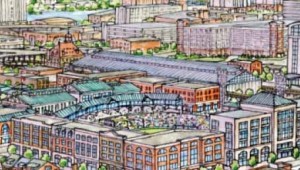 The Richmond Federal Reserve’s quarterly magazine about the Fifth District economy, Region Focus, came out this week with an article about the surge of baseball stadiums being built or proposed in the region.
The Richmond Federal Reserve’s quarterly magazine about the Fifth District economy, Region Focus, came out this week with an article about the surge of baseball stadiums being built or proposed in the region.
The article, “Ballpark Boom,” mentions the Highwoods Properties proposal to build a stadium in Shockoe Bottom. It also brings up points on both sides at to whether stadium complexes are good economic generators.
From the article:
Winston-Salem and Richmond are following a path Cleveland State University urban affairs professor and sports economist Mark Rosentraub advocates. “In more cases, these mixed-use developments have produced success,” he says.
“A sports facility is a very large capital asset,” Rosentraub says. “No one would buy or place a large capital asset in a specific location without a strategy.”
And on the other hand:
There are other ways to develop downtown areas than by stadiums, says Dennis Coates, an economics professor at the University of Maryland, Baltimore County.
There are numerous examples where promises about stadium-related development weren’t met, Coates says. … Typically, stadium advocates approach debates about subsidies by saying the venue will generate tax revenues and create new jobs, Coates says. There’s no evidence any of that happens, but that doesn’t mean the ideal stadium subsidy is necessarily zero.
The article also highlights the impact of recently built stadiums in the southeast, which Richmond decision makers should note as they consider the Shockoe proposal.
For example, the Class A Greensboro Grasshoppers have set attendance records in the last three years that they’ve played in their new stadium. While the stadium has been a success for the team, it hasn’t sparked development. The article states the stadium has several vacant properties nearby, including an empty Chevrolet dealership. A more-than-$60 million project proposed next to the stadium fell apart in 2006.
Fluor Field in Greenville, S.C., opened in 2006 and has attracted condos and restaurants around the ballpark. The Class A Drive have also set attendance records at the new stadium.
The PDF version of the article by David Van Den Berg is available here.
The Fed magazine also has a article about corporate bankruptcies and whether the current system is the most efficient way to determine the viability of a distressed company. You can read that one here.
 The Richmond Federal Reserve’s quarterly magazine about the Fifth District economy, Region Focus, came out this week with an article about the surge of baseball stadiums being built or proposed in the region.
The Richmond Federal Reserve’s quarterly magazine about the Fifth District economy, Region Focus, came out this week with an article about the surge of baseball stadiums being built or proposed in the region.
The article, “Ballpark Boom,” mentions the Highwoods Properties proposal to build a stadium in Shockoe Bottom. It also brings up points on both sides at to whether stadium complexes are good economic generators.
From the article:
Winston-Salem and Richmond are following a path Cleveland State University urban affairs professor and sports economist Mark Rosentraub advocates. “In more cases, these mixed-use developments have produced success,” he says.
“A sports facility is a very large capital asset,” Rosentraub says. “No one would buy or place a large capital asset in a specific location without a strategy.”
And on the other hand:
There are other ways to develop downtown areas than by stadiums, says Dennis Coates, an economics professor at the University of Maryland, Baltimore County.
There are numerous examples where promises about stadium-related development weren’t met, Coates says. … Typically, stadium advocates approach debates about subsidies by saying the venue will generate tax revenues and create new jobs, Coates says. There’s no evidence any of that happens, but that doesn’t mean the ideal stadium subsidy is necessarily zero.
The article also highlights the impact of recently built stadiums in the southeast, which Richmond decision makers should note as they consider the Shockoe proposal.
For example, the Class A Greensboro Grasshoppers have set attendance records in the last three years that they’ve played in their new stadium. While the stadium has been a success for the team, it hasn’t sparked development. The article states the stadium has several vacant properties nearby, including an empty Chevrolet dealership. A more-than-$60 million project proposed next to the stadium fell apart in 2006.
Fluor Field in Greenville, S.C., opened in 2006 and has attracted condos and restaurants around the ballpark. The Class A Drive have also set attendance records at the new stadium.
The PDF version of the article by David Van Den Berg is available here.
The Fed magazine also has a article about corporate bankruptcies and whether the current system is the most efficient way to determine the viability of a distressed company. You can read that one here.